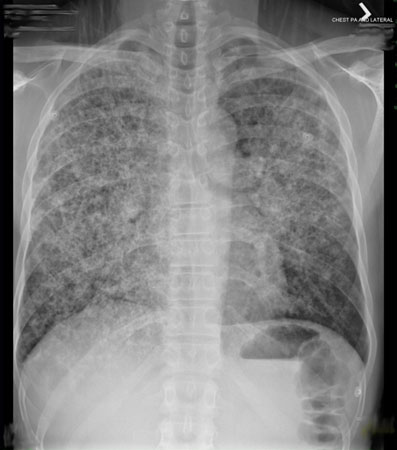Persistent pulmonary infiltrate results when a substance denser than air (e.g., pus, edema, blood, surfactant, protein, or cells) lingers within the lung parenchyma. Nonresolving and slowly resolving pneumonias are the most common broad categories of persistent pulmonary infiltrate.[1]Menendez R, Perpina M, Torres A. Evaluation of non-resolving and progressive pneumonia. Semin Respir Infect. 2003 Jun;18(2):103-11.
http://www.ncbi.nlm.nih.gov/pubmed/12840791?tool=bestpractice.com
[2]Kuru T, Lynch JP 3rd. Non-resolving or slowly resolving pneumonia. Clin Chest Med. 1999 Sep;20(3):623-51.
http://www.ncbi.nlm.nih.gov/pubmed/10516909?tool=bestpractice.com
[3]Cunha BA. Slowly resolving and nonresolving pneumonias. Drugs Today (Barc). 2000 Dec;36(12):829-34.
http://www.ncbi.nlm.nih.gov/pubmed/12845341?tool=bestpractice.com
Persistence is attributed to defects in host immune defense mechanisms, presence of unusual or resistant organisms, or diseases that mimic pneumonia.[4]Mittl RL Jr, Schwab RJ, Duchin JS, et al. Radiographic resolution of community-acquired pneumonia. Am J Respir Crit Care Med. 1994 Mar;149(3 Pt 1):630-5.
http://www.ncbi.nlm.nih.gov/pubmed/8118630?tool=bestpractice.com
[5]Orens JB, Sitrin RG, Lynch JP 3rd. The approach to nonresolving pneumonia. Med Clin North Am. 2004 Feb;52(2):224-9.
http://www.ncbi.nlm.nih.gov/pubmed/8078373?tool=bestpractice.com
Classification
The classification of these disorders may become quite complex, as some clinicians focus primarily on radiologic abnormalities, while others emphasize accompanying clinical features. Nonresolving or slowly resolving pneumonia is loosely defined as pneumonia that does not improve clinically, or even worsens, despite a minimum of 10 days of adequate antibiotic therapy or as radiographic infiltrate that does not resolve within 12 weeks.[6]El Solh AA, Aquilina AT, Gunen H, et al. Radiographic resolution of community-acquired bacterial pneumonia in the elderly. J Am Geriatr Soc. 2004 Feb;52(2):224-9.
http://www.ncbi.nlm.nih.gov/pubmed/14728631?tool=bestpractice.com
[7]Fein AM, Feinsilver SH, Niederman MS. Nonresolving or slowly resolving pneumonia: diagnosis and management in the elderly patient. Clin Chest Med. 1993 Sep;14(3):555-69.
http://www.ncbi.nlm.nih.gov/pubmed/8222569?tool=bestpractice.com
Slowly resolving pneumonia is usually defined as the persistence of radiographic infiltrate in a clinically improved patient for >4 weeks (<50% resolution in 1 month).[8]Eisenberg GM, Flippin HF, Israel HL, et al. Delayed resolution of pneumonias. Med Clin North Am. 1956 Sep;40(5):1291-303.
http://www.ncbi.nlm.nih.gov/pubmed/13358319?tool=bestpractice.com
[9]Kirtland SH, Winterbauer RH. Slowly resolving, chronic, and recurrent pneumonia. Clin Chest Med. 1991 Jun;12(2):303-18.
http://www.ncbi.nlm.nih.gov/pubmed/1855373?tool=bestpractice.com
[10]Rome L, Murali G, Lippmann M. Nonresolving pneumonia and mimics of pneumonia. Med Clin North Am. 2001 Nov;85(6):1511-30, xi.
http://www.ncbi.nlm.nih.gov/pubmed/11680114?tool=bestpractice.com
[11]Fein AM, Feinsilver SH. Non-resolving and slowly resolving pneumonia. In: Feinsilver SH, Fein AM, eds. Textbook of bronchoscopy. Baltimore, MD: Williams & Wilkins; 1995:286-301.
A waiting period of 12 to 14 weeks is suggested for slowly resolving pneumonia to be considered nonresolving (or chronic) in older patients with nontuberculous bacterial pneumonia.[6]El Solh AA, Aquilina AT, Gunen H, et al. Radiographic resolution of community-acquired bacterial pneumonia in the elderly. J Am Geriatr Soc. 2004 Feb;52(2):224-9.
http://www.ncbi.nlm.nih.gov/pubmed/14728631?tool=bestpractice.com
Nonresponding pneumonia is characterized by inadequate clinical response despite antibiotic treatment. It is an independent risk factor for death and delayed resolution of pulmonary infiltrate.[12]Menendez R, Torres A, Zalacaín R, et al. Neumofail Group. Risk factors of treatment failure in community acquired pneumonia: implications for disease outcome. Thorax. 2004 Nov;59(11):960-5.
http://www.pubmedcentral.nih.gov/picrender.fcgi?artid=1746855&blobtype=pdf
http://www.ncbi.nlm.nih.gov/pubmed/15516472?tool=bestpractice.com
[13]Menendez R, Torres A. Treatment failure in community-acquired pneumonia. Chest. 2007 Oct;132(4):1348-55.
http://www.ncbi.nlm.nih.gov/pubmed/17934120?tool=bestpractice.com
Noninfectious causes are responsible for about 20% of cases of nonresolving pneumonia.[12]Menendez R, Torres A, Zalacaín R, et al. Neumofail Group. Risk factors of treatment failure in community acquired pneumonia: implications for disease outcome. Thorax. 2004 Nov;59(11):960-5.
http://www.pubmedcentral.nih.gov/picrender.fcgi?artid=1746855&blobtype=pdf
http://www.ncbi.nlm.nih.gov/pubmed/15516472?tool=bestpractice.com
Therapeutic response
A good clinical response to pulmonary infiltrate is defined as a 50% clearing of chest radiographic findings at 4 weeks of therapy.[6]El Solh AA, Aquilina AT, Gunen H, et al. Radiographic resolution of community-acquired bacterial pneumonia in the elderly. J Am Geriatr Soc. 2004 Feb;52(2):224-9.
http://www.ncbi.nlm.nih.gov/pubmed/14728631?tool=bestpractice.com
Clinical improvement and resolution of leukocytosis support the conclusion that the patient has responded to antibiotic therapy, even when chest radiographic abnormalities persist.[2]Kuru T, Lynch JP 3rd. Non-resolving or slowly resolving pneumonia. Clin Chest Med. 1999 Sep;20(3):623-51.
http://www.ncbi.nlm.nih.gov/pubmed/10516909?tool=bestpractice.com
Most patients have a normal temperature and decreased cough within 3 to 5 days after beginning treatment. When clinical improvement has not occurred and chest radiographic findings are unchanged or worse, or if at least partial radiographic resolution is lacking by 4 weeks, further evaluation is essential, even in asymptomatic patients.[2]Kuru T, Lynch JP 3rd. Non-resolving or slowly resolving pneumonia. Clin Chest Med. 1999 Sep;20(3):623-51.
http://www.ncbi.nlm.nih.gov/pubmed/10516909?tool=bestpractice.com
[10]Rome L, Murali G, Lippmann M. Nonresolving pneumonia and mimics of pneumonia. Med Clin North Am. 2001 Nov;85(6):1511-30, xi.
http://www.ncbi.nlm.nih.gov/pubmed/11680114?tool=bestpractice.com
[14]Woodhead M, Blasi F, Ewig S, Garau J, et al. Guidelines for the management of adult lower respiratory tract infections - full version. Clin Microbiol Infect. 2011 Nov;17 (Suppl 6):E1-59.
https://www.clinicalmicrobiologyandinfection.com/article/S1198-743X(14)61404-X/fulltext
http://www.ncbi.nlm.nih.gov/pubmed/21951385?tool=bestpractice.com
This is the case for pneumonia, but persistent pulmonary infiltrates may result from other reasons (e.g., pulmonary edema).
Variant response
Resolution of nonresolving pneumonia varies and depends on the causal agent, the severity of disease, and host factors.[4]Mittl RL Jr, Schwab RJ, Duchin JS, et al. Radiographic resolution of community-acquired pneumonia. Am J Respir Crit Care Med. 1994 Mar;149(3 Pt 1):630-5.
http://www.ncbi.nlm.nih.gov/pubmed/8118630?tool=bestpractice.com
[6]El Solh AA, Aquilina AT, Gunen H, et al. Radiographic resolution of community-acquired bacterial pneumonia in the elderly. J Am Geriatr Soc. 2004 Feb;52(2):224-9.
http://www.ncbi.nlm.nih.gov/pubmed/14728631?tool=bestpractice.com
Several risk factors may hinder the rate of radiographic clearing of the condition:[2]Kuru T, Lynch JP 3rd. Non-resolving or slowly resolving pneumonia. Clin Chest Med. 1999 Sep;20(3):623-51.
http://www.ncbi.nlm.nih.gov/pubmed/10516909?tool=bestpractice.com
[15]Cassiere H, Rodrigues JC, Fein AM. Delayed resolution of pneumonia: when is slow healing too slow? Postgrad Med. 1996 Jan;99(1):151-4, 157-8.
http://www.ncbi.nlm.nih.gov/pubmed/8539201?tool=bestpractice.com
Age over 60 years: radiographic clearance of pneumonic infiltrate on completion of antibiotic therapy decreases by 20% per decade after the age of 20 years
Malnutrition
Comorbid conditions (COPD, cardiac failure, diabetes, renal failure, immunodeficiency, alcohol intake, smoking, occupational exposure, cancer, cancer treatment, systemic illness): patients with hematologic malignancies; immunosuppressive disorders; or exposure to silica, aluminum, or titanium dust are prone to persistent pulmonary infiltrate
Causal microorganism
Initial severity of the infection
Delay in initiation of therapy.

Log in or subscribe to access all of BMJ Best Practice